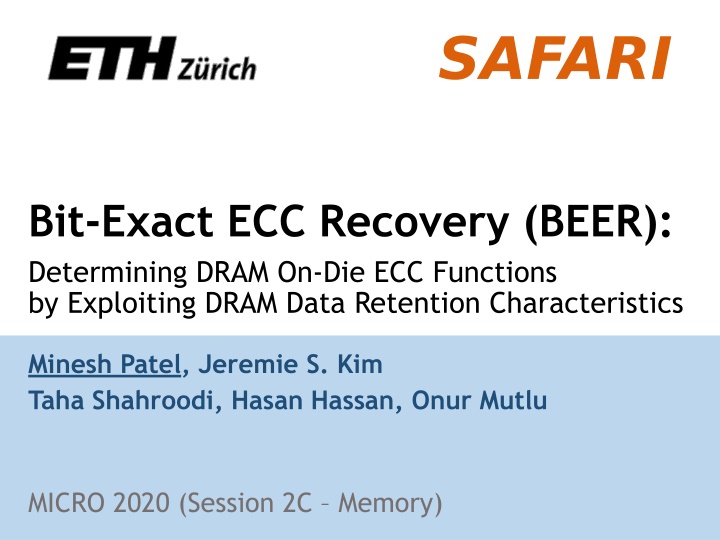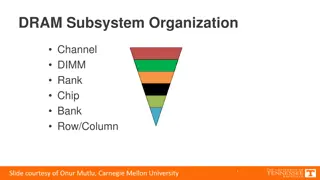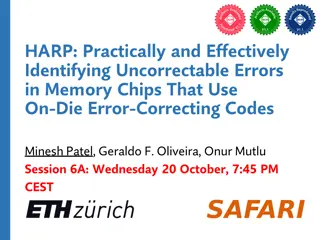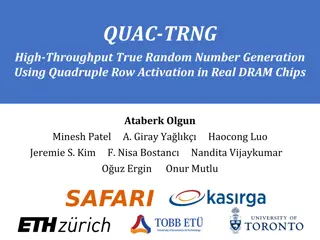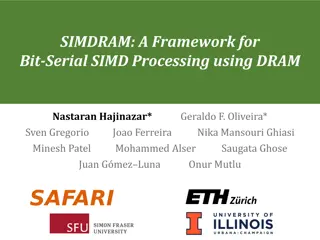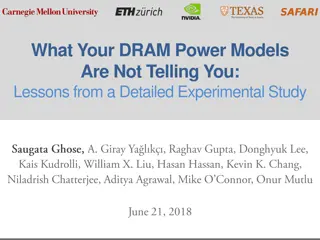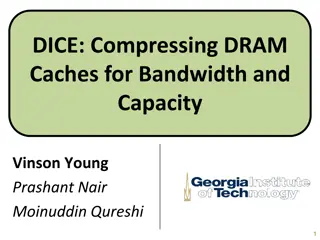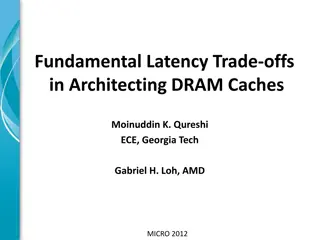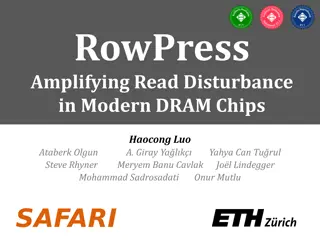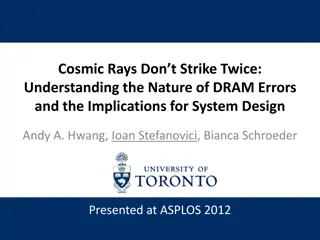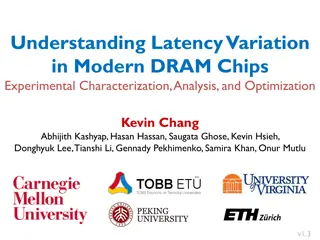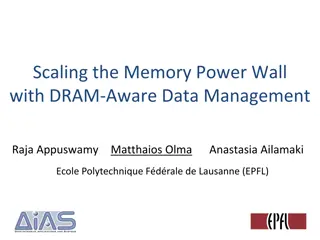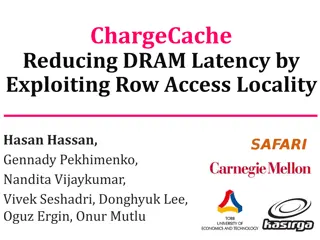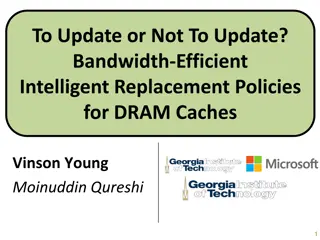Bit-Exact ECC Recovery: Determining DRAM On-Die ECC Functions
DRAM on-die ECC complicates third-party reliability studies by obfuscating raw bit errors. BEER introduces a new testing methodology to determine a DRAM chip's unique on-die ECC function, enabling valuable studies in the future.
Download Presentation

Please find below an Image/Link to download the presentation.
The content on the website is provided AS IS for your information and personal use only. It may not be sold, licensed, or shared on other websites without obtaining consent from the author.If you encounter any issues during the download, it is possible that the publisher has removed the file from their server.
You are allowed to download the files provided on this website for personal or commercial use, subject to the condition that they are used lawfully. All files are the property of their respective owners.
The content on the website is provided AS IS for your information and personal use only. It may not be sold, licensed, or shared on other websites without obtaining consent from the author.
E N D
Presentation Transcript
Bit-Exact ECC Recovery (BEER): Determining DRAM On-Die ECC Functions by Exploiting DRAM Data Retention Characteristics Minesh Patel, Jeremie S. Kim Taha Shahroodi, Hasan Hassan, Onur Mutlu MICRO 2020 (Session 2C Memory)
Executive Summary Problem: DRAM on-die ECC complicates third-party reliability studies Proprietary design obfuscates raw bit errors in an unpredictable way Interferes with (1) design, (2) test & validation, and (3) characterization Goal: understand exactlyhow on-die ECC obfuscates errors Contributions: 1.BEER: new testing methodology that determines a DRAM chip s unique on-die ECC function (i.e., its parity-check matrix) Exploits ECC-function-specific uncorrectable error patterns Requires no hardware support, inside knowledge, or metadata access 2.BEEP: new error profiling methodology that infers the raw bit error locations of error-prone cells from the observable uncorrectable errors BEER Evaluations: Apply BEER to 80 real LPDDR4 chips from 3 major DRAM manufacturers Show correctness in simulation for 115,300 codes (4-247b ECC words) We hope BEER and BEEP enable valuable studies in the future 2
Talk Outline Challenges Caused by Unknown On-Die ECCs BEER: Determining the On-Die ECC Function Evaluating BEER in Experiment and Simulation BEEP and Other Practical Use Cases for BEER 3
A Typical DRAM On-Die ECC Design 128-bit single-error correcting (SEC) Hamming code DRAM Chip 128+8 128 ECC Encoder Chip I/O Data Store External DRAM Bus 128 128+8 ECC Decoder Invisible outside the DRAM chip Fully contained within the chip 4
A Typical DRAM On-Die ECC Design DRAM Chip 128+8 128 ECC Encoder Chip I/O Data Store External DRAM Bus 128 128+8 ECC Decoder Many ways to implement a 128-bit Hamming code Different ECC functions Known as parity-check matrices (i.e.,?-matrices) All correct 1 error, but act differently on 2+ errors Manufacturers are free to choose any design Circuit optimization goals (e.g., area, power) Details are highly proprietary (even under NDA) 5
Effect of Different On-Die ECC Designs Simulating uniform-random errors in a 32b ECC word 0xFF test pattern @ RBER=10-4 Nonuniform errors 32-bit single-error correction Hamming codes Three different parity-check matrices 6
Effect of Different On-Die ECC Designs Simulating uniform-random errors in a 32b ECC word 0xFF test pattern @ RBER=10-4 Nonuniform errors The same error characteristics can appear very different with different ECC functions 32-bit single-error correction Hamming codes Three different parity-check matrices 7
Challenges for Third Parties System Architects: Designing Error Mitigations On-die ECC forces system architects to support unpredictable, chip-dependent memory reliability characteristics Test/Validation Engineers: Post-Manufacturing Testing On-die ECC hides theroot-causes of uncorrectable errors and defeats test patterns designed to target physical cells Research Scientists: Error-Characterization Studies On-die ECC conflates raw bit errors with ECC artifacts, effectively obfuscating the true physical cell characteristics 8
Challenges for Third Parties System Architects: Designing Error Mitigations On-die ECC forces system architects to support unpredictable, chip-dependent memory reliability characteristics Test/Validation Engineers: Post-Manufacturing Testing These challenges all arise from the inability to predict On-die ECC hides theroot-causes of uncorrectable errors and defeats test patterns designed to target physical cells how ECC transforms error patterns Research Scientists: Error-Characterization Studies On-die ECC conflates raw bit errors with ECC artifacts, effectively obfuscating the true physical cell characteristics 9
Overcoming Challenges of On-Die ECC Our goal: Determine the on-die ECC function without: (1) hardware support or tools (2) prior knowledge about on-die ECC (3) access to ECC metadata (e.g., syndromes) ??????? DRAM Chip I/O Data Store ??????? Reveals how on-die ECC scrambles errors (BEER) Allows inferring raw bit error locations (BEEP) 10
Talk Outline Challenges Caused by Unknown On-Die ECCs BEER: Determining the On-Die ECC Function Evaluating BEER in Experiment and Simulation BEEP and Other Practical Use Cases for BEER 11
Determining the ECC Function (1/2) Key idea: identify the ECC function by how it responds to uncorrectable data-retention errors Initially CHARGED Data-Retention Error REF REF DRAM Cell CPU or FPGA Pause Voltage DRAM Refresh VSAFE Initially DISCHARGED Time Difference between CHARGED and DISCHARGED cells allows us to restrict errors to specific bit positions Test Pattern Encoded Data ???????? 1 0 0 0 ? ? ? 1 0 0 0 Possible errors are limited to certain bits Assume data is stored unmodified (systematic encoding) 12 CHARGED
Determining the ECC Function (2/2) Test Pattern Encoded Data ?????? C D D D C D D D D D C Parity-check bits Induce data-retention errors Different ??cause different uncorrectable errors Possible Error Patterns No error C - - - - - C Post-Correction Data Correctable ?? D - - - - - C C D D D ?? ?? ?? C - - - - - D C C D D C D C D Uncorrectable ?????? D - - - - - D C D D C 13
Determining the ECC Function (2/2) Test Pattern Encoded Data ?????? C D D D C D D D D D C Induce data-retention errors We can differentiate ECC functions Different ??cause different uncorrectable errors Possible Error Patterns No error from their uncorrectable error patterns C - - - - - C Post-Correction Data Correctable ?? D - - - - - C C D D D ?? ?? ?? C - - - - - D C C D D C D C D Uncorrectable ?????? D - - - - - D C D D C 14
Choosing a Set of Test Patterns We consider the ?-CHARGED test patterns: , . . . , , . . . , , . . . , } } } 1-CHARGED = { 2-CHARGED = { 3-CHARGED = { C D D D D C D D D D D C , , , C C D D C D C D D D C C C C C D C D C C D D C C Our paper explains that the combined {1,2}-CHARGED patterns are sufficient to identify the ECC function For each test pattern, we find all possible uncorrectable errors that can occur Exploit uniform-randomness of data-retention errors Even one DRAM chip provides millions of samples E.g., 2 GiB DRAM module yields 224 128-bit words 15
BEER: Bit-Exact ECC Recovery Experimentally induce data-retention errors using {1,2}-CHARGED test patterns 1 For each test pattern, identify all possible uncorrectable errors 2 Solve for the ECC function with the observed behavior using a SAT solver 3 16
Talk Outline Challenges Caused by Unknown On-Die ECCs BEER: Determining the On-Die ECC Function Evaluating BEER in Experiment and Simulation BEEP and Other Practical Use Cases for BEER 17
Experimental Methodology 80 LPDDR4 chips from 3 DRAM manufacturers Manufacturers anonymized as A , B , and C Temperature-controlled testing infrastructure Control over DRAM timings (including refresh) Refresh windows between 1-30 minutes at 30-80 C Leads to bit error rates (BERs) between 10-7 and 10-3 BERs far larger than other soft error rates 18
Applying BEER to LPDDR4 Chips Study the uncorrectable errors in the 1-CHARGED patterns Variation between manufacturers indicates different ECC functions Miscorrections Data retention errors within CHARGED bits Repeating patterns indicate structure in the H-matrix 19
Applying BEER to LPDDR4 Chips Study the uncorrectable errors in the 1-CHARGED patterns Variation between manufacturers indicates different ECC functions Miscorrections 1. Different manufacturers appear to use different on-die ECC functions 2. Chips of the same model number appear to use identical ECC functions (shown in our paper) Data retention errors within CHARGED bits Repeating patterns indicate structure in the H-matrix 20
Solving for the ECC Function We use the Z3 SAT solver to identify the ?-matrix We demonstrate BEER for SEC Hamming codes, but it should readily extend to all linear block codes (e.g., BCH) We open-source our BEER implementation on GitHub https://github.com/CMU-SAFARI/BEER Unfortunately, we face two limitations to validation: 1. No way to check the final results since we cannot see into the on-die ECC implementation 2. We cannot share our final matrices due to confidentiality reasons L. De Moura and N. Bj rner, Z3: An Effient SMT Solver, TACAS, 2008. 21
Solving for the ECC Function We use the Z3 SAT solver to identify the ?-matrix We demonstrate BEER for SEC Hamming codes, but it should readily extend to all linear block codes (e.g., BCH) We validate BEER in simulation to: 1. Evaluate correctness 2. Overcome confidentiality issues 3. Test a larger set of ECC codes We open-source our BEER implementation on GitHub https://github.com/CMU-SAFARI/BEER Unfortunately, we face two limitations to validation: 1. No way to check the final results since we cannot see into the on-die ECC implementation 2. We cannot share our final matrices due to confidentiality reasons L. De Moura and N. Bj rner, Z3: An Effient SMT Solver, TACAS, 2008. 22
Simulation Methodology We use the EINSim DRAM error-correction simulator We simulate 115,300 different SEC Hamming codes ECC dataword lengths from 4 to 247 bits 1-, 2-, 3-, and {1,2}-CHARGED test patterns For each test pattern: Simulate 109ECC words ( 14.9 GiB for 128-bit words) Simulate data-retention errors with BER between 10-5 and 10-2 Patel et al., Understanding and Modeling On-Die Error Correction in Modern DRAM: An Experimental Study Using Real Devices, DSN, 2019. 23
BEER Correctness Evaluation Evaluate the number of SAT solutions found by BEER Shows whether the unique solution is identified 1-, 2-, 3-CHARGED patterns individually do not always succeed {1,2} -CHARGED patterns succeed for all test cases 24
BEER Correctness Evaluation Evaluate the number of SAT solutions found by BEER Shows whether the unique solution is identified BEER successfully identifies the ECC function using the {1,2}-CHARGED test patterns 1-, 2-, 3-CHARGED patterns individually do not always succeed {1,2} -CHARGED patterns succeed for all test cases 25
Talk Outline Challenges Caused by Unknown On-Die ECCs BEER: Determining the On-Die ECC Function Evaluating BEER in Experiment and Simulation BEEP and Other Practical Use Cases for BEER 26
Practical Use Cases for BEER We provide 5 use cases in our paper to show how knowing the ECC function is useful in practice BEEP: identifying raw bit error locations corresponding to observed post-correction errors Error Profiling Architecting DRAM controller error mitigations that are informed about on-die ECC System Design Crafting worst-case test patterns to enable efficient testing and validation Testing Root-cause analysis for uncorrectable errors Error Studying the statistical properties of raw bit errors (e.g., spatial distributions) Characterization 27
Other Information in the Paper Formalism for BEER and the ?-CHARGED test patterns BEER evaluations using experiment and simulation Sensitivity to experimental noise Analysis of experimental runtime Practicality of the SAT problem (i.e., runtime, memory) BEEP evaluations in simulation Accuracy at different error rates Sensitivity to different ECC codes and word sizes Detailed discussion of use-cases for BEER Discussion on BEER s requirements and limitations 28
Executive Summary Problem: DRAM on-die ECC complicates third-party reliability studies Proprietary design obfuscates raw bit errors in an unpredictable way Interferes with (1) design, (2) test & validation, and (3) characterization Goal: understand exactlyhow on-die ECC obfuscates errors Contributions: 1.BEER: new testing methodology that determines a DRAM chip s unique on-die ECC function (i.e., its parity-check matrix) 2.BEEP: new error profiling methodology that infers the raw bit error locations of error-prone cells from the observable uncorrectable errors BEER Evaluations: Apply BEER to 80 real LPDDR4 chips from 3 major DRAM manufacturers Show correctness in simulation for 115,300 codes (4-247b ECC words) https://github.com/CMU-SAFARI/BEER We hope that both BEER and BEEP enable many valuable studies going forward 29
Bit-Exact ECC Recovery (BEER): Determining DRAM On-Die ECC Functions by Exploiting DRAM Data Retention Characteristics Minesh Patel, Jeremie S. Kim Taha Shahroodi, Hasan Hassan, Onur Mutlu MICRO 2020 (Session 2C Memory)
